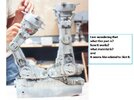Hey Josh, didn't start the new project thread we talked about yet where this should probably go but this is still related to this thread as the picture below might help with pin placement distance ratios. These are more accurate shapes and what I will be printing from.
Almost have a full upper leg with linked pistons and motion drivers to the knee fly wheel worked up with pin placements and ranges of motion. The positions of the completed parts (except the pistons) as I move them through the motions seem to match what I see on the screen pretty well so far but man there are a lot of dependencies with the pieces. Using solid linkages to drive everything requires making lots of little adjustments to pack everything in the leg.
It has occurred to me that driving the pistons with a strap and elastic was actually a pretty genius and simple way of doing it. To capture the full range of motion I see on the screen the piston fly wheel seems to need to rotate more than the fixed range of motion a direct hard link would provide. By putting a semi-rigid strap across the small center post to create rolling friction and an elastic over the strap to hold it in place, a very long length of travel is achieved and the elastic can stretch to accommodate the changing distance between the anchor points without the strap slipping on the rotating post until the limits of piston travel are reached.
View attachment 1462740
Currently trying to simulate the strap and elastic with a curved rack and pinion type of drive but on a larger center diameter. It will have to have sections of no teeth at each end to provide the slip action I think is there in the models action and a pivoting constraint (not shown) to keep it in contact with the pinion. It is on the back side of the can so as to not interfere with the pistons. Not a straight forward solution and might not work in the end. Here is what I have so far. The piston driver is not in the right place yet and the cam angles need some adjustment.
View attachment 1462739
The more I work on this the more impressed I am with what the model builders created.


